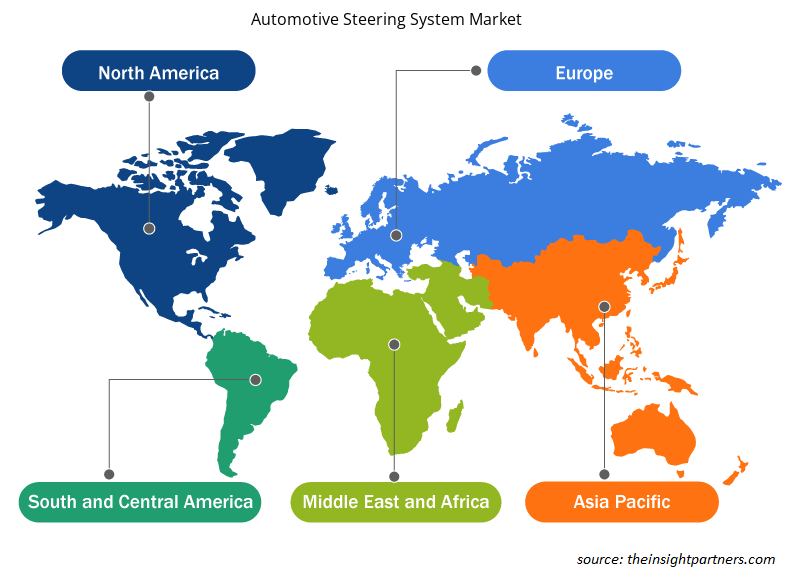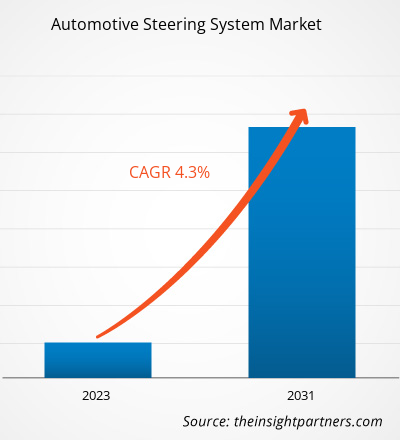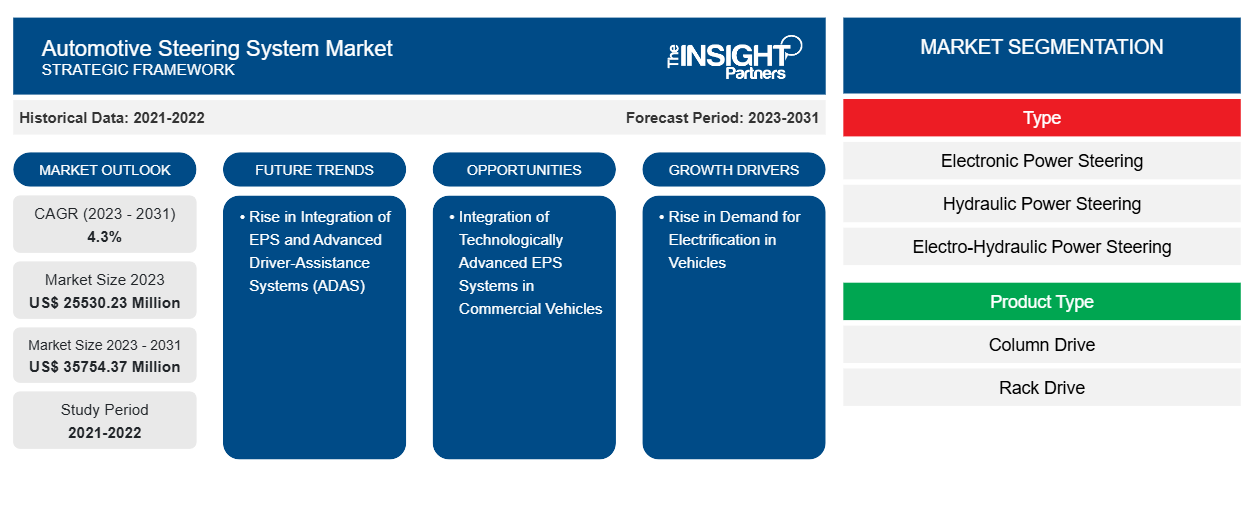Der Markt für Lenksysteme für Kraftfahrzeuge soll von 25.530,23 Millionen US-Dollar im Jahr 2023 auf 35.754,37 Millionen US-Dollar im Jahr 2031 wachsen. Der Markt soll zwischen 2023 und 2031 eine durchschnittliche jährliche Wachstumsrate (CAGR) von 4,3 % verzeichnen. Mehrere Regierungen weltweit haben strenge Gesetze zu Kraftfahrzeugabgasen und Kraftstoffverbrauch erlassen. Regulierungsbehörden wie die National Highway Traffic and Safety Administration in den USA und der International Council on Clean Transportation in Europa setzen Vorschriften auf Flottenebene durch. Automobilhersteller müssen die durch diese Vorschriften festgelegten durchschnittlichen Schadstoffgrenzwerte einhalten. Diese Vorschriften haben Automobilhersteller dazu veranlasst, mehr in kraftstoffsparende Lenksysteme wie elektronische Servolenkungen zu investieren. Im Gegensatz zu herkömmlichen hydraulischen Lenksystemen sind elektrisch unterstützte Servolenkungen leichter und einfacher aufgebaut.
Marktanalyse für Lenksysteme für Kraftfahrzeuge
Laut dem US-Energieministerium können EPS-Systeme (elektronische Servolenkung) unter idealen Bedingungen die Kraftstoffeffizienz um 2 bis 4 % verbessern, den Kraftstoffverbrauch um bis zu 6 % senken und den CO2-Ausstoß um 8 Gramm pro Kilometer reduzieren. Nach Schätzungen der Nexteer Automotive Corporation haben EPS-Systeme seit 1999 fast 3 Milliarden Gallonen Benzin eingespart. Anders als hydraulische Systeme, die bei laufendem Motor kontinuierlich Flüssigkeit pumpen, verbrauchen diese Systeme nur dann Strom, wenn die Räder gedreht werden. Die Region Europa weist die höchste Verbreitung elektrisch unterstützter Servolenkungen auf, gefolgt von Nordamerika und dem asiatisch-pazifischen Raum. Daher wird erwartet, dass die verschiedenen strengen staatlichen Normen zur Gewährleistung kraftstoffeffizienter Fahrzeuge auf der Straße die Nachfrage nach EPS beeinflussen und so im Prognosezeitraum zum Marktwachstum beitragen werden.
Marktübersicht für Automobil-Lenksysteme
Die Integration des Internets der Dinge in Autos ist die nächste bedeutende digitale Entwicklung in der Automobilindustrie. Das Aufkommen autonomer Fahrzeuge wird eine weitere Revolution in der Automobilindustrie mit sich bringen. Autonome Fahrzeuge mit integriertem elektronischem Servolenkungssystem (EPS) werden das Fahrerlebnis des Benutzers weiter verbessern. Die Entwicklung vernetzter Autos bietet sowohl Technologieunternehmen als auch der Automobilindustrie vielversprechende Möglichkeiten. Die Entwicklung vernetzter Fahrzeuge würde den Einsatz von EPS in den Fahrzeugen fördern und so im Prognosezeitraum zum Wachstum des globalen Marktes für Automobillenksysteme beitragen.
Passen Sie diesen Bericht Ihren Anforderungen an
Sie erhalten kostenlose Anpassungen an jedem Bericht, einschließlich Teilen dieses Berichts oder einer Analyse auf Länderebene, eines Excel-Datenpakets sowie tolle Angebote und Rabatte für Start-ups und Universitäten.
-
Holen Sie sich die wichtigsten Markttrends aus diesem Bericht.Dieses KOSTENLOSE Beispiel umfasst eine Datenanalyse von Markttrends bis hin zu Schätzungen und Prognosen.
Treiber und Chancen auf dem Markt für Automobil-Lenksysteme
Steigende Nachfrage nach Elektrifizierung von Fahrzeugen
Weltweit werden immer mehr Busse und Lastwagen eingesetzt, insbesondere für Logistik und öffentliche Verkehrsmittel. In Asien, Ozeanien und Europa wird der öffentliche Nahverkehr dem privaten Verkehr vorgezogen, während in Nordamerika Privatwagen das wichtigste Verkehrsmittel sind. Da die Bevölkerung in städtischen Gebieten wächst, besteht ein Bedarf an mehr öffentlichen Verkehrsmitteln, und die derzeitige Verkehrsinfrastruktur erweist sich als unzureichend. OEMs weltweit konzentrieren sich nun darauf, die globalen Kohlenstoffemissionen zu senken, was zu einer zunehmenden Nutzung von Elektroautos führt. Bei Personenkraftwagen und Taxis konzentriert man sich mit steigender Nachfrage stärker auf die Einführung umweltfreundlicherer Technologien. Die Hersteller konzentrieren ihre Bemühungen auf die Elektrifizierung von Fahrzeugen, insbesondere Personenkraftwagen. Mehrere Länder weltweit unternehmen große Anstrengungen, um umweltfreundliche Verkehrsmittel zu schaffen. So veröffentlichten beispielsweise das chinesische Verkehrsministerium und andere Ministerien im Mai 2019 gemeinsam den Aktionsplan für umweltfreundliches Reisen für 2019–2022, der die Nutzung umweltfreundlicher Fahrzeuge fördert. Darüber hinaus wird das Land weiterhin den öffentlichen Nahverkehr und Informationssysteme verbessern, die umweltfreundliche Verkehrsmittel fördern.
Regierungen auf der ganzen Welt ergreifen verschiedene Maßnahmen, um die CO2-Emissionen zu minimieren. Sie bieten Steuererleichterungen und Anreize, um die Nutzung von Elektrofahrzeugen im öffentlichen Verkehr wie E-Trucks und E-Bussen zu fördern. BYD K9, der Elektro-Truck von Mercedes Benz und die E-Busse Tata Starbus Hybrid sind einige Beispiele für Elektrofahrzeugmodelle. Einige Nutzfahrzeughersteller haben kürzlich Elektrobusse vorgestellt, und andere haben Pläne angekündigt, große Lastwagen und Pickups auf batterieelektrische Plattformen umzustellen. Somit trägt die steigende Nachfrage nach Elektrofahrzeugen zum Wachstum des globalen Marktes für Automobillenksysteme bei.
Integration technologisch fortschrittlicher EPS-Systeme in Nutzfahrzeuge
EPS wird hauptsächlich in Personenkraftwagen und leichten Nutzfahrzeugen verwendet, in schweren Fahrzeugen ist es in geringem Maße vertreten. Dank des technologischen Fortschritts können EPS-Systeme mehr Gewicht tragen und in Nutzfahrzeugen eingesetzt werden. Aufgrund ihrer höheren Tragfähigkeit als EPS-Systeme dominieren derzeit HPS-Systeme (Hydraulic Power Steering) den Nutzfahrzeugmarkt. HPS-Systeme nutzen die Steuerung des Motors und reduzieren so die Kraftstoffeffizienz.
Das EPS-System ist kraftstoffeffizienter und zuverlässiger als HPS-Systeme, da es Strom aus dem Tank bezieht. Aufgrund der höheren Tragfähigkeit kann diese Technologie auch in Nutzfahrzeugen eingesetzt werden. Volvo hat beispielsweise Volvo Dynamic Steering entwickelt, das einen Elektromotor verwendet. Die Lenkung wird 2.000 Mal pro Sekunde vom Motor geregelt. Zum Aufbau dieser Technologie wurde die Torque Overlay-Plattform verwendet. Für die Pickup-Truck-Industrie hat Nexteer Automotive eine elektronische Servolenkung mit Zahnstangenunterstützung entwickelt. Das elektrohydraulische Lenksystem Servotwin für schwere Nutzfahrzeuge wurde von Robert Bosch, einem weiteren führenden Hersteller von Lenksystemen, eingeführt. Ebenso brachte Nexteer Automotive Corporation im Oktober 2020 EPS-Systeme für Nutzfahrzeuge auf den Markt. In den kommenden Jahren dürften solche Fortschritte lukrative Möglichkeiten für EPS-Systeme auf dem Nutzfahrzeugmarkt schaffen.
Segmentierungsanalyse des Marktberichts für Kfz-Lenksysteme
Wichtige Segmente, die zur Ableitung der Marktanalyse für Automobil-Lenksysteme beigetragen haben, sind Typ, Produkttyp und Fahrzeugtyp.
- Je nach Typ ist der Markt in elektronische Servolenkung, hydraulische Servolenkung und elektrohydraulische Servolenkung unterteilt. Das Segment der elektronischen Servolenkung hatte im Jahr 2023 einen größeren Marktanteil.
- Basierend auf dem Produkttyp ist der globale Markt für Automobillenksysteme in Lenksäulenantrieb und Zahnstangenantrieb unterteilt. Das Segment Zahnstangenantrieb hatte im Jahr 2023 einen größeren Marktanteil.
- Basierend auf dem Fahrzeugtyp ist der Markt in Personenkraftwagen und Nutzfahrzeuge unterteilt. Das Segment Personenkraftwagen hatte im Jahr 2023 einen größeren Marktanteil.
Marktanteilsanalyse für Automobil-Lenksysteme nach Geografie
Der globale Markt für Automobillenksysteme ist in fünf große Regionen unterteilt: Nordamerika, Europa, APAC, Naher Osten und Afrika (MEA) sowie Südamerika (SAM). Die USA, Kanada und Mexiko sind die wichtigsten Volkswirtschaften in der nordamerikanischen Region. Die Region ist einer der größten Automobilproduktionsstandorte weltweit. Die Präsenz etablierter Automobilhersteller und Hersteller von Automobillenksystemen in Nordamerika treibt den Markt an. Das Wirtschaftswachstum der Region hat sich positiv auf den Verkauf von Nutzfahrzeugen und Personenkraftwagen ausgewirkt. Automobillenksysteme werden in Personenkraftwagen und Nutzfahrzeuge integriert, um die Richtung eines fahrenden Fahrzeugs zu steuern. Die steigenden Verkäufe von Personenkraftwagen und Nutzfahrzeugen erhöhen die Nachfrage nach Automobillenksystemen. Im Jahr 2020 wurden in der Region 13.375.622 Einheiten von Personenkraftwagen und Nutzfahrzeugen produziert. Mittlerweile ist die elektronische Servolenkung zu einem alltäglichen Merkmal der Fahrzeuge geworden. Sie macht eine Servolenkungspumpe und Hydraulikflüssigkeiten überflüssig. Früher war die elektronische Servolenkung für High-End-Fahrzeuge oder SUVs konzipiert. Die Zuverlässigkeit der elektronischen Servolenkung hat jedoch zu ihrer Verbreitung in fast allen Fahrzeugtypen geführt. Die zunehmende Bedeutung elektronischer Servolenkungen treibt den Markt in Nordamerika an.
Regionale Einblicke in den Markt für Automobil-Lenksysteme
Die regionalen Trends und Faktoren, die den Markt für Kfz-Lenksysteme im Prognosezeitraum beeinflussen, wurden von den Analysten von Insight Partners ausführlich erläutert. In diesem Abschnitt werden auch die Marktsegmente und die Geografie von Kfz-Lenksystemen in Nordamerika, Europa, im asiatisch-pazifischen Raum, im Nahen Osten und Afrika sowie in Süd- und Mittelamerika erörtert.

- Erhalten Sie regionale Daten zum Markt für Automobil-Lenksysteme
Umfang des Marktberichts zum Kfz-Lenksystem
| Berichtsattribut | Details |
|---|---|
| Marktgröße im Jahr 2023 | 25.530,23 Millionen US-Dollar |
| Marktgröße bis 2031 | 35.754,37 Millionen US-Dollar |
| Globale CAGR (2023 - 2031) | 4,3 % |
| Historische Daten | 2021-2022 |
| Prognosezeitraum | 2023–2031 |
| Abgedeckte Segmente |
Nach Typ
|
| Abgedeckte Regionen und Länder |
Nordamerika
|
| Marktführer und wichtige Unternehmensprofile |
|
Marktteilnehmerdichte: Der Einfluss auf die Geschäftsdynamik
Der Markt für Automobil-Lenksysteme wächst rasant, angetrieben durch die steigende Nachfrage der Endnutzer aufgrund von Faktoren wie sich entwickelnden Verbraucherpräferenzen, technologischen Fortschritten und einem größeren Bewusstsein für die Vorteile des Produkts. Mit steigender Nachfrage erweitern Unternehmen ihr Angebot, entwickeln Innovationen, um die Bedürfnisse der Verbraucher zu erfüllen, und nutzen neue Trends, was das Marktwachstum weiter ankurbelt.
Die Marktteilnehmerdichte bezieht sich auf die Verteilung der Firmen oder Unternehmen, die in einem bestimmten Markt oder einer bestimmten Branche tätig sind. Sie gibt an, wie viele Wettbewerber (Marktteilnehmer) in einem bestimmten Marktraum im Verhältnis zu seiner Größe oder seinem gesamten Marktwert präsent sind.
Die wichtigsten auf dem Markt für Automobil-Lenksysteme tätigen Unternehmen sind:
- China Automotive Systems Inc
- Nexteer Automobile
- Hitachi Automotive Systems Americas, Inc
- Hyundai Mobis
- JTEKT Corporation
- Mando Corporation
Haftungsausschluss : Die oben aufgeführten Unternehmen sind nicht in einer bestimmten Reihenfolge aufgeführt.

- Überblick über die wichtigsten Akteure auf dem Markt für Kfz-Lenksysteme
Neuigkeiten und aktuelle Entwicklungen zum Markt für Kfz-Lenksysteme
Der Markt für Automobillenksysteme wird durch die Erfassung qualitativer und quantitativer Daten nach Primär- und Sekundärforschung bewertet, die wichtige Unternehmensveröffentlichungen, Verbandsdaten und Datenbanken umfasst. Im Folgenden finden Sie eine Liste der Entwicklungen auf dem Markt für Innovationen, Geschäftserweiterungen und Strategien:
- Im Januar 2022 brachte China Automotive Systems Inc. eine neue EPS-Serie für BYD Auto auf den Markt. BYD ersetzt die Racktype-EPS seiner beliebten High-End-Fahrzeugmodelle durch DP-EPS, und China Automotive Systems Inc. wurde mit der Entwicklung und Lieferung derselben beauftragt. Letzteres hat bereits mit der Massenproduktion von DP-EPS begonnen und erwartet, jährlich etwa 300.000 Einheiten auszuliefern. (Quelle: China Automotive Systems Inc., Pressemitteilung)
Marktbericht zu Lenksystemen für Kraftfahrzeuge – Umfang und Ergebnisse
Der Bericht „Marktgröße und Prognose für Kfz-Lenksysteme (2021–2031)“ bietet eine detaillierte Analyse des Marktes, die die folgenden Bereiche abdeckt:
- Marktgröße und Prognose für Automobil-Lenksysteme auf globaler, regionaler und Länderebene für alle abgedeckten wichtigen Marktsegmente.
- Marktdynamik wie Treiber, Beschränkungen und wichtige Chancen
- Markttrends für Automobillenksysteme
- Detaillierte PEST/Porters Five Forces- und SWOT-Analyse
- Marktanalyse für Automobillenksysteme mit wichtigen Markttrends, globalen und regionalen Rahmenbedingungen, wichtigen Akteuren, Vorschriften und jüngsten Marktentwicklungen
- Marktumfeld und Wettbewerbsanalyse für Automobil-Lenksysteme, einschließlich Marktkonzentration, Heatmap-Analyse, prominenten Akteuren und aktuellen Entwicklungen.
- Detaillierte Firmenprofile
- Historische Analyse (2 Jahre), Basisjahr, Prognose (7 Jahre) mit CAGR
- PEST- und SWOT-Analyse
- Marktgröße Wert/Volumen – Global, Regional, Land
- Branchen- und Wettbewerbslandschaft
- Excel-Datensatz
Aktuelle Berichte
Erfahrungsberichte
Grund zum Kauf
- Fundierte Entscheidungsfindung
- Marktdynamik verstehen
- Wettbewerbsanalyse
- Kundeneinblicke
- Marktprognosen
- Risikominimierung
- Strategische Planung
- Investitionsbegründung
- Identifizierung neuer Märkte
- Verbesserung von Marketingstrategien
- Steigerung der Betriebseffizienz
- Anpassung an regulatorische Trends























 Kostenlose Probe anfordern für - Markt für Automobillenksysteme
Kostenlose Probe anfordern für - Markt für Automobillenksysteme